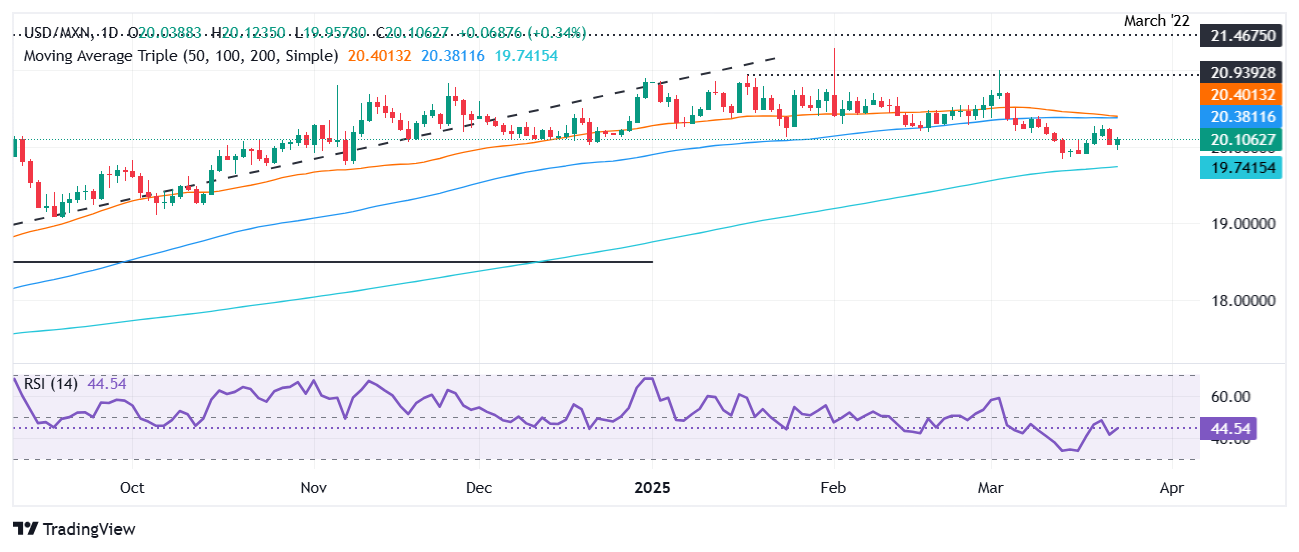- Mexican Peso weakens 0.24% even as DXY slips, reflecting Banxico rate cut expectations.
- Data shows resilient Retail Sales, but economic contraction fuels a dovish policy outlook.
- Citi survey predicts Banxico cutting 50 bps this week; markets also eye US PCE inflation print.
The Mexican Peso (MXN) dips against the US Dollar (USD) in early trading during Tuesday’s North American session, as the emerging market currency fails to advance following a strong Retail Sales report for January, released by the Instituto Nacional de Estadística, Geografía e Informática (INEGI). At the time of writing, USD/MXN exchange rate is 20.07, up 0.24%.
The Peso remains on the defensive, even though the Greenback posts losses, as depicted by the US Dollar Index (DXY). The DXY, which measures the performance of the American currency against other six, falls 0.23% and clings to the 104.00 figure.
INEGI reported that consumers continue to spend at a good pace, as revealed by Retail Sales. Nevertheless, January’s economic contraction and the dip in mid-month inflation in March had increased the odds that Banco de Mexico (Banxico) would reduce interest rates by 50 basis points (bps) at its Thursday meeting, from 9.50% to 9%.
The Citi Expectations Survey revealed that most private economists expect Banxico to reduce rates by 50 basis points. According to the survey, Mexico’s primary reference rate is expected to end 2025 at 8%, down from 8.25%.
Given the backdrop, further upside is seen in USD/MXN. However, if US President Donald Trump makes tariff exemptions to Mexico, the outlook for the economy could improve. Hence, the Peso could strengthen and exert downward pressure on the exotic pair.
Ahead this week, Mexico’s docket will feature the Balance of Trade and Banxico’s interest rate decision. Across the border, the US schedule will feature the release of the Fed’s preferred inflation gauge, the core Personal Consumption Expenditures (PCE) Price Index.
Daily digest market movers: Mexican Peso drops ahead of imminent Banxico rate cut
- Mexico’s Retail Sales in January grew by 0.6% MoM, up from December’s 0.1% and estimates of 0.1%. In the twelve months to January, sales rose by 2.7%, up from a contraction of 0.2%, crushing forecasts of 1.1%.
- On Monday, the Consumer Price Index (CPI) for the first half of March dipped compared to estimates on both a monthly and annual basis. Core inflation stood within Banxico’s target of 3% plus or minus 1% on inflation.
- The Citi Mexico Expectations Survey revealed that analysts expect interest rates to end at 8% in 2025, down from 8.25% in the previous release. USD/MXN is expected to end at 20.98, down from 21.00 in the last survey.
- Inflation expectations remained anchored in the high 3% range, while GDP is foreseen to expand by 0.6%, down from 0.8% in the last survey.
- Traders had priced the Fed to ease policy by 65 basis points (bps) throughout the year, as revealed by data from the Chicago Board of Trade.
USD/MXN technical outlook: Mexican Peso loses traction as USD/MXN rises past 20.10
USD/MXN trade has been choppy, consolidating around the 20.00–20.20 range for the last couple of days, with neither buyers nor sellers able to break the range. It’s worth noting that the pair is tilted to the downside after sellers cleared strong support at the 50 and 100-day Simple Moving Averages (SMAs) at 20.38, 20.22, which exacerbated the downtrend below 20.20.
For a bearish continuation, a drop below 20.00 is needed. If cleared, nothing is in the way to test the 200-day SMA at 19.70, followed by the September 18 swing low of 19.06. On the other hand, if bulls clear the 20.20 mark, the USD/MXN pair would be poised to test the confluence of the 100 and 50-day SMAs, ahead of the 20.50 area.
Mexican Peso FAQs
The Mexican Peso (MXN) is the most traded currency among its Latin American peers. Its value is broadly determined by the performance of the Mexican economy, the country’s central bank’s policy, the amount of foreign investment in the country and even the levels of remittances sent by Mexicans who live abroad, particularly in the United States. Geopolitical trends can also move MXN: for example, the process of nearshoring – or the decision by some firms to relocate manufacturing capacity and supply chains closer to their home countries – is also seen as a catalyst for the Mexican currency as the country is considered a key manufacturing hub in the American continent. Another catalyst for MXN is Oil prices as Mexico is a key exporter of the commodity.
The main objective of Mexico’s central bank, also known as Banxico, is to maintain inflation at low and stable levels (at or close to its target of 3%, the midpoint in a tolerance band of between 2% and 4%). To this end, the bank sets an appropriate level of interest rates. When inflation is too high, Banxico will attempt to tame it by raising interest rates, making it more expensive for households and businesses to borrow money, thus cooling demand and the overall economy. Higher interest rates are generally positive for the Mexican Peso (MXN) as they lead to higher yields, making the country a more attractive place for investors. On the contrary, lower interest rates tend to weaken MXN.
Macroeconomic data releases are key to assess the state of the economy and can have an impact on the Mexican Peso (MXN) valuation. A strong Mexican economy, based on high economic growth, low unemployment and high confidence is good for MXN. Not only does it attract more foreign investment but it may encourage the Bank of Mexico (Banxico) to increase interest rates, particularly if this strength comes together with elevated inflation. However, if economic data is weak, MXN is likely to depreciate.
As an emerging-market currency, the Mexican Peso (MXN) tends to strive during risk-on periods, or when investors perceive that broader market risks are low and thus are eager to engage with investments that carry a higher risk. Conversely, MXN tends to weaken at times of market turbulence or economic uncertainty as investors tend to sell higher-risk assets and flee to the more-stable safe havens.
Information on these pages contains forward-looking statements that involve risks and uncertainties. Markets and instruments profiled on this page are for informational purposes only and should not in any way come across as a recommendation to buy or sell in these assets. You should do your own thorough research before making any investment decisions. FXStreet does not in any way guarantee that this information is free from mistakes, errors, or material misstatements. It also does not guarantee that this information is of a timely nature. Investing in Open Markets involves a great deal of risk, including the loss of all or a portion of your investment, as well as emotional distress. All risks, losses and costs associated with investing, including total loss of principal, are your responsibility. The views and opinions expressed in this article are those of the authors and do not necessarily reflect the official policy or position of FXStreet nor its advertisers. The author will not be held responsible for information that is found at the end of links posted on this page.
If not otherwise explicitly mentioned in the body of the article, at the time of writing, the author has no position in any stock mentioned in this article and no business relationship with any company mentioned. The author has not received compensation for writing this article, other than from FXStreet.
FXStreet and the author do not provide personalized recommendations. The author makes no representations as to the accuracy, completeness, or suitability of this information. FXStreet and the author will not be liable for any errors, omissions or any losses, injuries or damages arising from this information and its display or use. Errors and omissions excepted.
The author and FXStreet are not registered investment advisors and nothing in this article is intended to be investment advice.
Recommended content
Editors’ Picks

EUR/USD clings to gains above 1.1350 after mixed US data
EUR/USD stays in positive territory above 1.1350 in the American session on Thursday. The US Dollar (USD) struggles to gather strength following the mixed macroeconomic data releases from the US, allowing the pair to cling to its daily gains.

GBP/USD holds steady near 1.3300 on renewed USD weakness
GBP/USD stabilizes at around 1.3300 in the second half of the day on Thursday as the USD finds it difficult to build on this week's gains. The uncertainty surrounding the US-China trade relations moving forward and mixed data releases from the US help the pair hold its ground.

Gold rebounds after sharp decline, holds comfortably above $3,300
After posting large losses on Tuesday and Wednesday, Gold gathered recovery momentum and advanced toward $3,350 on Thursday. Markets remain wary of a re-escalation of the US-China trade conflict, helping XAU/USD find demand as a safe haven.

Bitcoin Price corrects as increased profit-taking offsets positive market sentiment
Bitcoin (BTC) is facing a slight correction, trading around $92,000 at the time of writing on Thursday after rallying 8.55% so far this week. Institutional demand remained strong as US spot Exchange Traded Funds (ETFs) recorded an inflow of $916.91 million on Wednesday.

Five fundamentals for the week: Traders confront the trade war, important surveys, key Fed speech Premium
Will the US strike a trade deal with Japan? That would be positive progress. However, recent developments are not that positive, and there's only one certainty: headlines will dominate markets. Fresh US economic data is also of interest.

The Best brokers to trade EUR/USD
SPONSORED Discover the top brokers for trading EUR/USD in 2025. Our list features brokers with competitive spreads, fast execution, and powerful platforms. Whether you're a beginner or an expert, find the right partner to navigate the dynamic Forex market.



